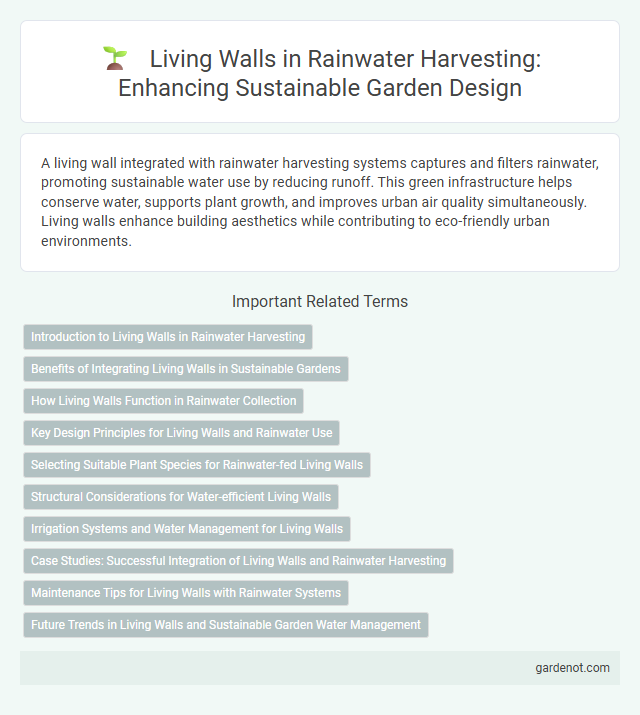A living wall integrated with rainwater harvesting systems captures and filters rainwater, promoting sustainable water use by reducing runoff. This green infrastructure helps conserve water, supports plant growth, and improves urban air quality simultaneously. Living walls enhance building aesthetics while contributing to eco-friendly urban environments.
Introduction to Living Walls in Rainwater Harvesting
Living walls, also known as green walls or vertical gardens, integrate vegetation into building facades to enhance rainwater harvesting by capturing and filtering runoff. These systems reduce stormwater runoff volume, improve water quality by filtering pollutants, and promote groundwater recharge through natural absorption processes. Incorporating living walls in urban rainwater management contributes to sustainable water conservation and reduces pressure on conventional drainage infrastructure.
Benefits of Integrating Living Walls in Sustainable Gardens
Living walls enhance rainwater harvesting by naturally filtering and absorbing runoff, reducing water waste and improving garden irrigation efficiency. The integration of living walls increases biodiversity by providing habitats for beneficial insects and plants that thrive in moist environments. Their ability to moderate microclimates also lowers garden temperatures, promoting healthier plant growth and conserving water resources.
How Living Walls Function in Rainwater Collection
Living walls function in rainwater collection by capturing and filtering rainwater through their layered plant systems and substrate, which absorb and retain moisture efficiently. The root structures of living walls facilitate natural filtration, reducing runoff and improving water quality before it infiltrates the soil or drainage systems. This system enhances urban water management by minimizing stormwater overflow and promoting sustainable use of rainwater for irrigation and cooling effects.
Key Design Principles for Living Walls and Rainwater Use
Living walls optimize rainwater harvesting by integrating permeable substrates and moisture-retentive plants that enhance water absorption and reduce runoff. Key design principles include selecting drought-tolerant species, ensuring proper irrigation distribution through drip systems, and incorporating water storage layers for sustainable rainwater use. Efficient rainwater management in living walls promotes urban cooling, air purification, and biodiversity while minimizing water waste.
Selecting Suitable Plant Species for Rainwater-fed Living Walls
Selecting suitable plant species for rainwater-fed living walls involves prioritizing drought-tolerant and native plants that thrive with variable moisture levels. Succulents, ferns, and grasses with deep root systems enhance water absorption and retention, improving overall system efficiency. Utilizing diverse plant species supports biodiversity while optimizing rainwater use and wall sustainability.
Structural Considerations for Water-efficient Living Walls
Water-efficient living walls require robust structural support to handle the combined weight of saturated growing media and water reservoirs, often necessitating reinforced framing materials like steel or treated timber. Proper waterproof membranes and drainage layers are critical to prevent water damage and ensure efficient rainwater capture and distribution within the vertical garden system. Integrating lightweight substrates and modular design elements optimizes water retention while maintaining structural integrity and reduces maintenance needs in rainwater harvesting applications.
Irrigation Systems and Water Management for Living Walls
Living walls utilize advanced irrigation systems designed to optimize rainwater harvesting by efficiently capturing and distributing collected water throughout the vertical garden structure. These systems often incorporate drip irrigation and automated moisture sensors to ensure precise water delivery, reducing waste and enhancing plant health. Effective water management in living walls promotes sustainable urban greenery and conserves valuable water resources by maximizing harvested rainwater usage.
Case Studies: Successful Integration of Living Walls and Rainwater Harvesting
Case studies demonstrate the successful integration of living walls with rainwater harvesting systems in urban environments, significantly reducing stormwater runoff and enhancing building insulation. Projects like the CaixaForum Museum in Madrid utilize harvested rainwater to irrigate vertical gardens, promoting biodiversity and lowering water consumption by up to 30%. Data from Singapore's Marina Bay Sands reveal that combining living walls with rainwater harvesting can improve air quality and reduce urban heat island effects while efficiently managing rainwater onsite.
Maintenance Tips for Living Walls with Rainwater Systems
Maintaining living walls equipped with rainwater harvesting systems requires regular inspection of water distribution components to prevent clogs and ensure even moisture delivery. Monitor soil moisture levels and trim plants to promote healthy growth while avoiding over-saturation that can lead to root rot. Periodic cleaning of filters and gutters maximizes rainwater flow efficiency, supporting sustainable irrigation and reducing reliance on traditional water sources.
Future Trends in Living Walls and Sustainable Garden Water Management
Living walls integrated with rainwater harvesting systems represent a cutting-edge trend in sustainable garden water management, enhancing water efficiency and reducing urban runoff. Advances in smart irrigation technology and sensor-driven automation optimize water use, ensuring plants receive precise moisture levels while minimizing waste. Future developments focus on combining living walls with greywater recycling and renewable energy sources, promoting eco-friendly urban landscapes that conserve resources and improve air quality.
Living wall Infographic

 gardenot.com
gardenot.com